Přednáška na bratislavském gymnáziu na Skalické ulici
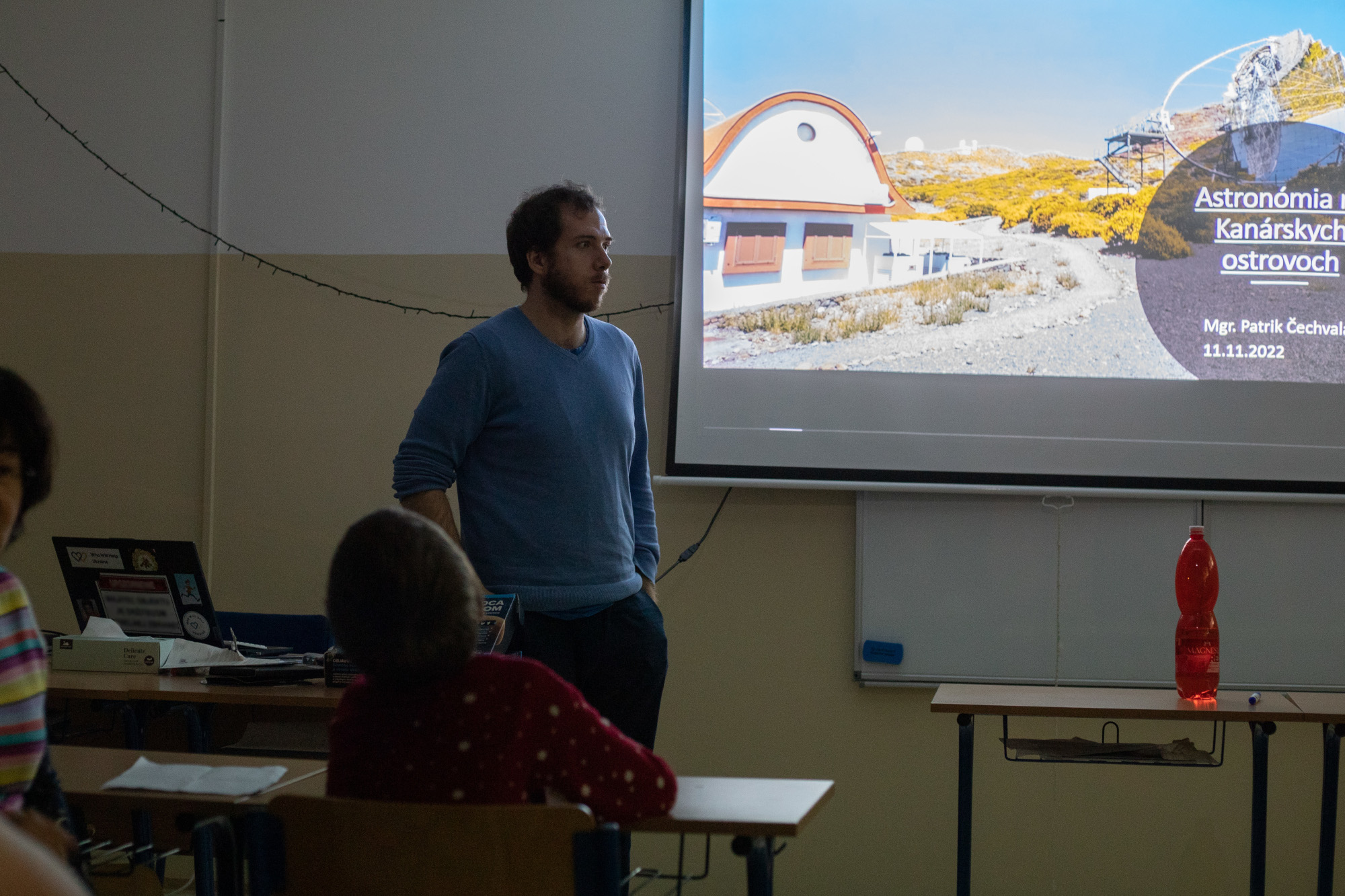
Dne 11.11.2022 proběhla popularizační přednáška věnovaná astronomii na Kanárských ostrovech
Mgr. Patrik Čechvala
Department of Astronomy, Physics of Earth and Meteorology
Comenius University in Bratislava, Slovakia
11.11.2022
T-Exkurze
Observatórium v Ondřejove malo 27. a 28. októbra privítať mladých záujemcov o astronómiu, ktorí sa v rámci programu Talnetu T-Exkurze mali pozrieť na Perkov 2m teleskop a vyskúšať si pomocou neho pozorovanie exoplanét. Vzhľadom na nepriaznivý stav pandemickej situácie sa nakoniec T-Exkurzia uskutočnila iba v online forme.
T-Exkurzie sa nakoniec zúčastnilo 7 žiakov. Dva týždne pred jej začiatkom dostali účastníci učebný text s informáciami o exoplanétach a ich výskume. Spolu s tým dostali aj dve jednoduché úlohy na overenie pochopenia témy.
Samotná exkurzia prebiehala v dvoch dňoch, pričom prvý deň začal popoludňajšou úvodnou prednáškou o exoplanétach. Hneď po nej začala diskusia o výbere cieľov na pozorovanie s astronómami, ktorí pravidelne pozorujú s Perkovým 2m ďalekohľadom. Ďalším bodom programu bola "virtuálna" video-prehliadka samotného ďalekohľadu. Prvý deň programu bol zakončený inštruktážou k praktickej úlohe - analýze grafu tranzitu exoplanéty. Na vypracovanie úlohy mali účastníci čas do poobedia druhého dňa. Následne prezentovali svoje výsledky a diskutovali ich medzi sebou i s astronómami pozorujúcimi pomocou Perkovho ďalekohľadu. Program bol zakončený diskusiou o hľadaní života vo vesmíre. Účastníci mali veľa zaujímavých nápadov a úvah, ktorými prispeli do diskusie.
Po skončení akcie účastníci vypracovali tzv. T-Report, kde mohli ľubovoľnou formou zhrnúť a popísať svoje zážitky z T-Exkurzie. Niektorí zvolili formu pozorovateľského denníku, iní pripravili krátke video.
Celá akcia sa niesla v tvorivom duchu, účastníkov nadchla téma výskumu exoplanét. Prejavili tiež záujem prísť si osobne pozrieť Perkov 2m ďalekohľad a vyskúšať si s ním skutočné astronomické pozorovanie. Niektorí z účastníkov už mali predošlé znalosti z danej oblasti a v budúcnosti by radi pokračovali v podobnej aktivite aj na náročnejšej úrovni.
Odkazy na prezentace:
- Pozorovánı́, popis a charakterizace exoplanet pomocı́ 2m Perkova dalekohledu
- Je tam niekde život?
- Stopárov sprievodca exoplanétami
- Videoprohlídka Perkova teleskopu v Ondřejove - youtube
European Collaborating Astronomer Projects: Espana-Czechia-Slovakia – Univerzita Komenského v Bratislave 2022
Mediálne výstupy:
- Juraj Tóth:
- Katolicke noviny, profilovy rozhovor, cislo venovane univerzitnemu vzdelavaniu Na Zemi mi je zatiaľ dobre - Profil - Katolícke noviny (katolickenoviny.sk), 29.9.
- Ranné správy RTVS - Televízny archív – pôvodná tvorba i športové relácie online 19. minuta zatmenie, 25.10.
- Pusté Úľany dostali suvenír z vesmíru. Čierny objekt teraz skúmajú vedci - Regióny - Správy – Pravda, www.pravda.sk
- Tlačová správa TASR, V obci Pusté Úľany pri Galante našli meteorit - tlačová správa, 20.9.
- Roman Nagy:
- Markíza – Televízne noviny – Detektor tmavej hmoty (11.07.2022)
- Markíza – Televízne noviny – Ľudská posádka na Mars (05.07.2022)
- Markíza – Televízne noviny – Misia na Marse (30.6.2022)
- JOJ – rozhovor – Slnovrat (21.5.2022)
- STV – rozhovor – Supermesiac (15.6.2022) link 0:43
- SRo – diskusia o 20tej - Kontakty – Misie na Marse (10.3.2022) link
- role.tv – Instagram – James Webb (6.2.2022)
- Markíza – Teleráno – Magneter (31.1.2022)
- Markíza – Televízne noviny – Magnetar (27.1.2022)
- SME – rozhovor – Centrálna čierna diera (12.5.2022) link
- Aktuality.sk – článok - Žiarivý objav najtemnejšieho objektu vesmíru (2.10.2022) link
- Jiří Šilha:
- "Mohutný vesmírny Webbov teleskop rozvinul krídla." pre časopis Trend. 23.1.
- "Vesmírny odpad – tichá hrozba" pre portál Aktuality.sk, 27.2.
- "Ľudský odpad pristane na odvrátenej strane Mesiaca skôr ako astronauti" pre Denník N, 4.3.
- RTVS Experiment - diskusia k projektu Artemis/Capstone a o budúcnosti letov človeka na Mesiac, 6.6.
- "Prečo sa chce Amerika vrátiť na Mesiac a prečo chcú pristáť inde ako počas programu Apollo" pre Denník N, 2.9.
- "Raketu SLS zrejme stiahnu z rampy, štart misie Artemis I sa môže posunúť až na koniec októbra" pre Denník N, 5.9.
- "Silná stránka Slovákov vo vesmírnom výskume? Astronóm Šilha hovorí, čo vieme ponúknuť ESA" pre denník SME., 27.9.
Popularizačné prednášky
- Juraj Tóth:
- Gymnazium Sv. Rodiny, Petrzalka, Ako vznikol vesmír, hviezdy a planéty?, 5.10.
- Gymnazium Sv. Ursule, Ako vznikol vesmír, hviezdy a planéty? , 6.10.
- Detska univerzita UK Prečo a ako vznikol vesmír, hviezdy a planéty? 27.7.
- Roman Nagy:
- Space::Talk (Space::Lab, SAV Košice), Košice, 28.04. – pozvaná prednáška - Mliečna cesta, naša rodná galaxia/The Milky Way, our home galaxy link youtube
- Slovenská Advokátska Komora, Tále, 02.06.-04.06. – pozvaná prednáška - (fyzikálne) zákony času - od počiatku vesmíru až po jeho zánik/Laws of Time – from the Begining of the Universe to the End
- Pohoda festival, Astrofyzici v sfére – od počiatku vesmíru po jeho koniec/The Astrophysicists in the Sphere – from the Begining of the Universe to the End, diskusia 09.07.
- ComiscSalón, Vesmírne čarovanie teleskopu Jamesa Webba/James Webb Space Telescope, prednáška, 17.9.
- Šoltésove dni pedagogiky fyziky, James Webb Space Telescope, prednáška 26.10.
Hvězdy z Ondřejova jsou v Chile
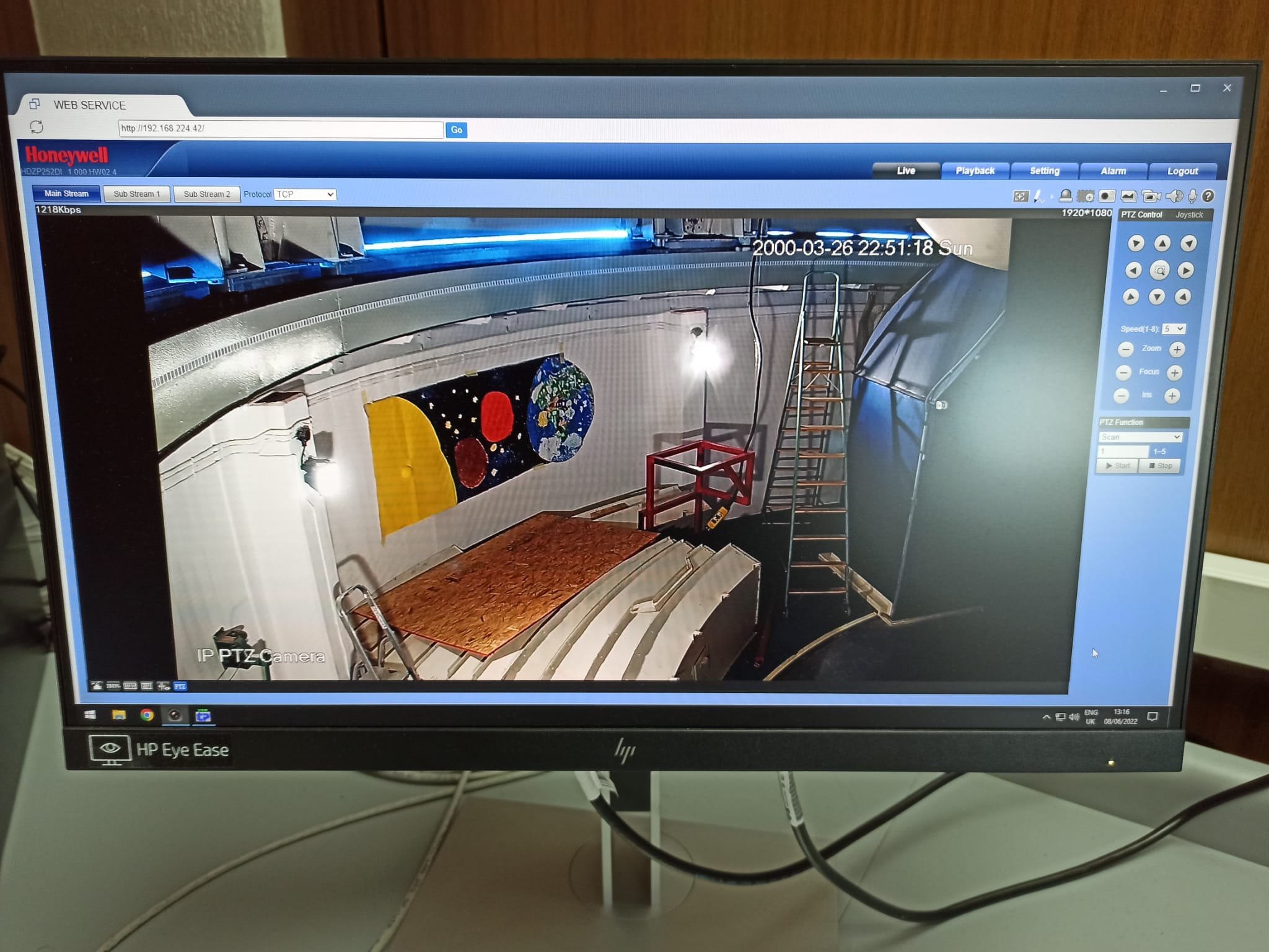
Předškoláci z MŠ Ondřejov se svými učitelkami vytvořili krásné obrázky vesmíru a planetárních soustav a naší Země. Po vernisáži, kde svá díla prezentovali (psali jsme – viz článek níže) kolegové ze Stelárního oddělení Luděk Řezba a Jiří Srba dostali důležitý úkol jednu z kreseb neporušenou dopravit do Chile k dalekohledu E152.
E152 je zmodernizovaný dalekohled na observatoři La Silla, který bude pod českým vedením hledat mimo jiné exoplanety. Shodou okolností byl tento dalekohled inaugurován na La Silla jako jeden z prvních a zhruba ve stejné době jako Perkův dalekohled zde v Ondřejově.
Kresba dětí je krásným příkladem spolupráce AsÚ s MŠ a je skvělé, že předškoláci v Ondřejově mají nyní jeden ze svých výtvorů na druhé straně Zeměkoule.
Stars from Ondřejov in Chile
Preschoolers from Ondřejov prepared a beautiful painting with their teachers. The theme was our place in the Universe and the painting was a large format of planetary system along with our Earth.
E152 is newly upgraded telescope at La Silla, Chile which will be hunting for exoplanets. E152 was opened for science as one of the first telescopes at La Silla and by coincidence around the same time as Perek telescope in Ondřejov.
The painting is an excellent example of collaboration of young kids and the Astronomical institute. The preschoolers from Ondřejov have their stars in Chile.
26.8.2022
Vážky a Ještěrky na hvězdárně
Jako každý rok se na hvězdárnu vypravili předškoláci z MŠ Ondřejov ze tŕid Ještěrek a Vážek. Během první návštevy 20. dubna děti přišly k Perkovu dalekohledu, největšímu v naší zemi, kde si prohlédly pozorovací místnost a poté samotný dalekohled. V kopuli dvoumetrového dalekohledu jsme si povídali o životě hvězd. Děti se z krátké prezentace promítané na kopuli dalekohledu dozvěděly, jak se rodí hvězdy, jak dospívají a jak zanikají. Nakonec děti dostaly zadání zpracovat toto téma do formy obrázků nebo jiných děl, které pak budou prezentovány na vernisáži v knihovně ondřejovské hvězdárny.
Ještě před rozloučením jsme nabrali tekutý dusík používaný při práci s dalekohledem a mrazili jsme větvičky, lístky a šišky. To se dětem líbilo zřejmě nejvíce.
Vernisáž dětských děl pak proběhla 19. května v knihovně hvězdárny Astronomického ústavu AV ČR za přítomnosti rodičů. Celou akci krátce uvedla ředitelka MŠ Romana Brilová, ředitel Astronomického ústavu AV ČR Michal Bursa a starosta obce Ondřejov Vladimír Zámyslický. Obě třídy si díky svým paním učitelkám připravily krásný program a své výtvory děti vystavily na stolech knihovny. Po společenském programu se podávalo drobné občerstvení a rodiče se mohli seznámit s díly svých ratolestí. Celá akce byla krásným příkladem setkávání místní komunity.
Setkání bylo opravdu velmi vydařené a jen potvrzuje skvělou symbiózu Astronomického ústavu AV ČR a MŠ Ondřejov. Je skvělé, že už i předškoláci mají úžasné znalosti o vesmíru a díky svým vyučujícím a samozřejmě rodinám jsou vedeni ke kreativitě. Zajímavostí je, že dva velké obrázky budou vystaveny - jeden v Chile u dalekohledu E152, který bude využíván českými vědci, druhý na Obecním úřadě v Ondřejově.
Moc děkujeme ředitelce a učitelkám třidy Vážek a Ještěrek a kolegům z ondřejovské hvězdárny, kteří pomáhali s organizací akce.
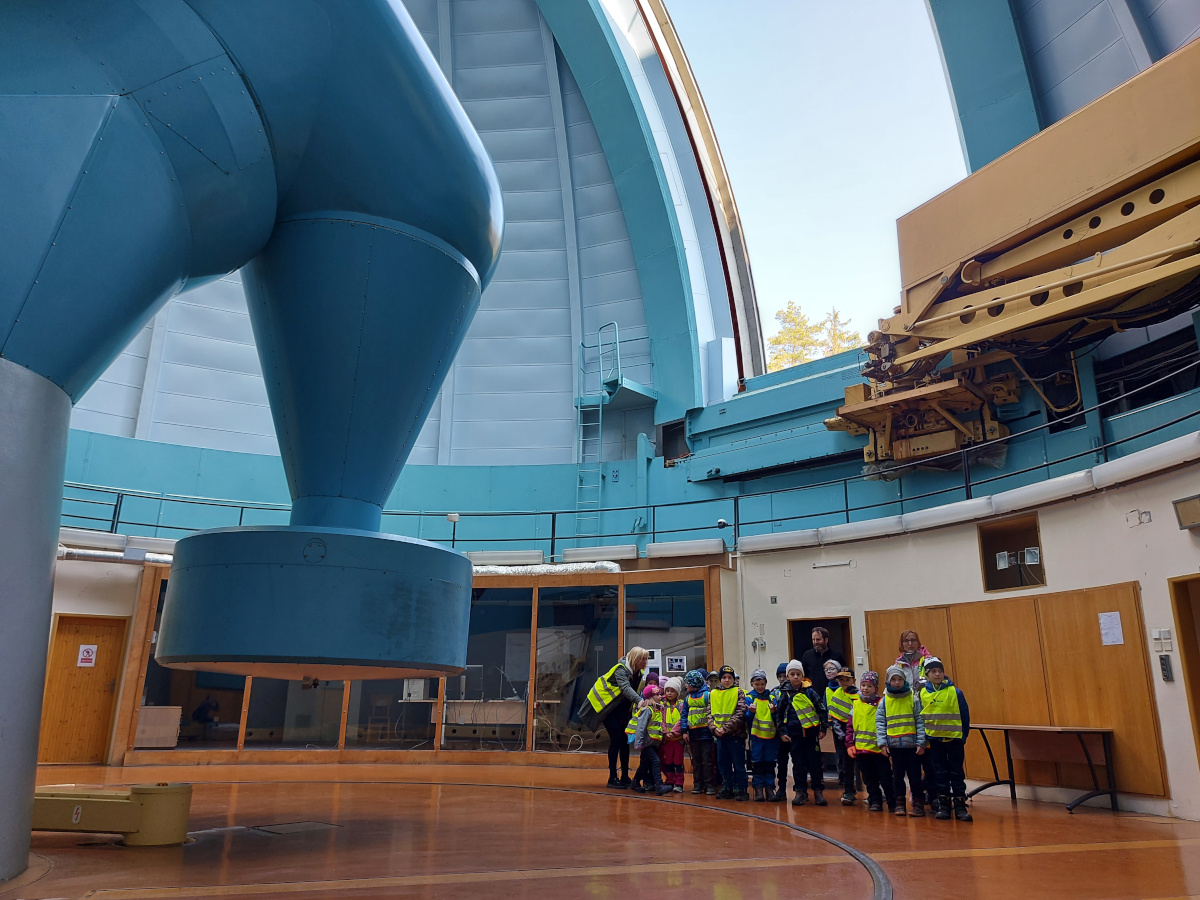
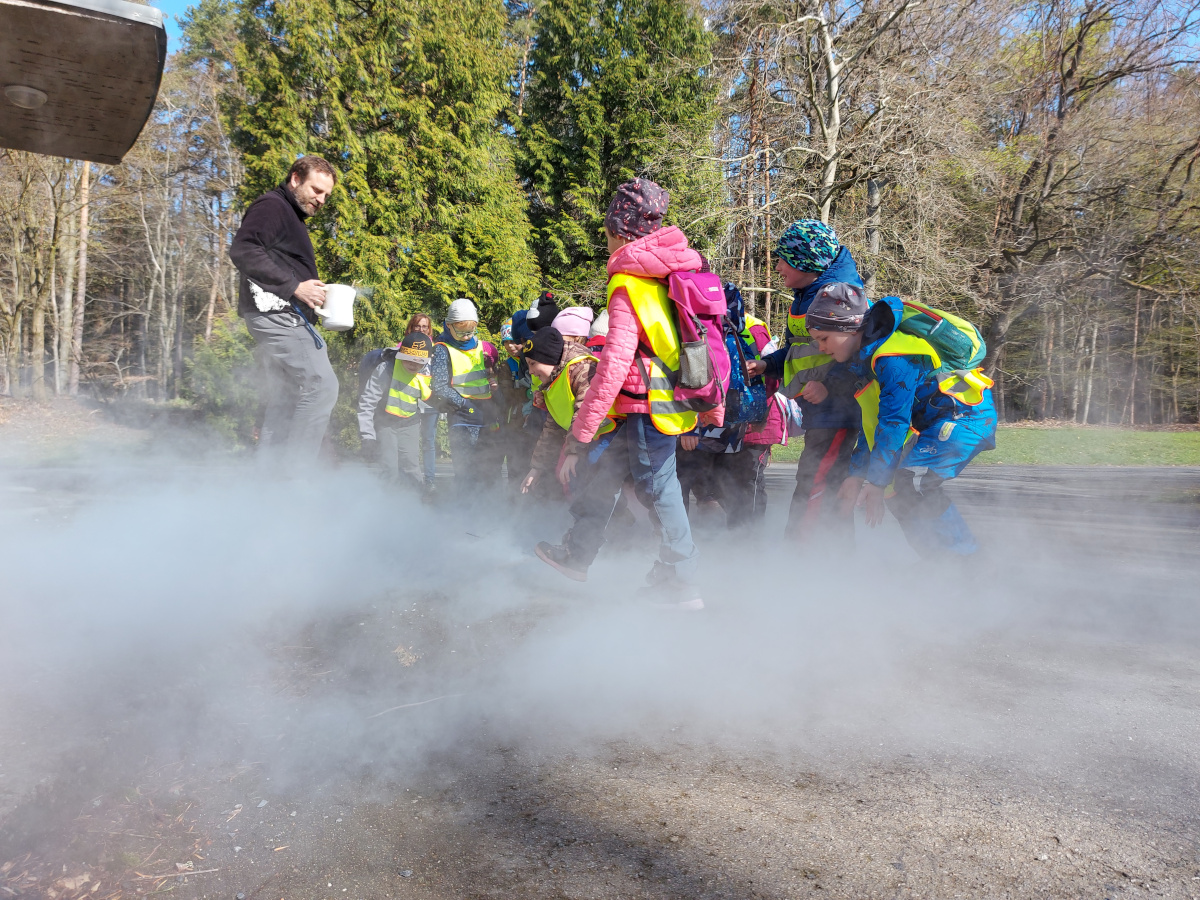
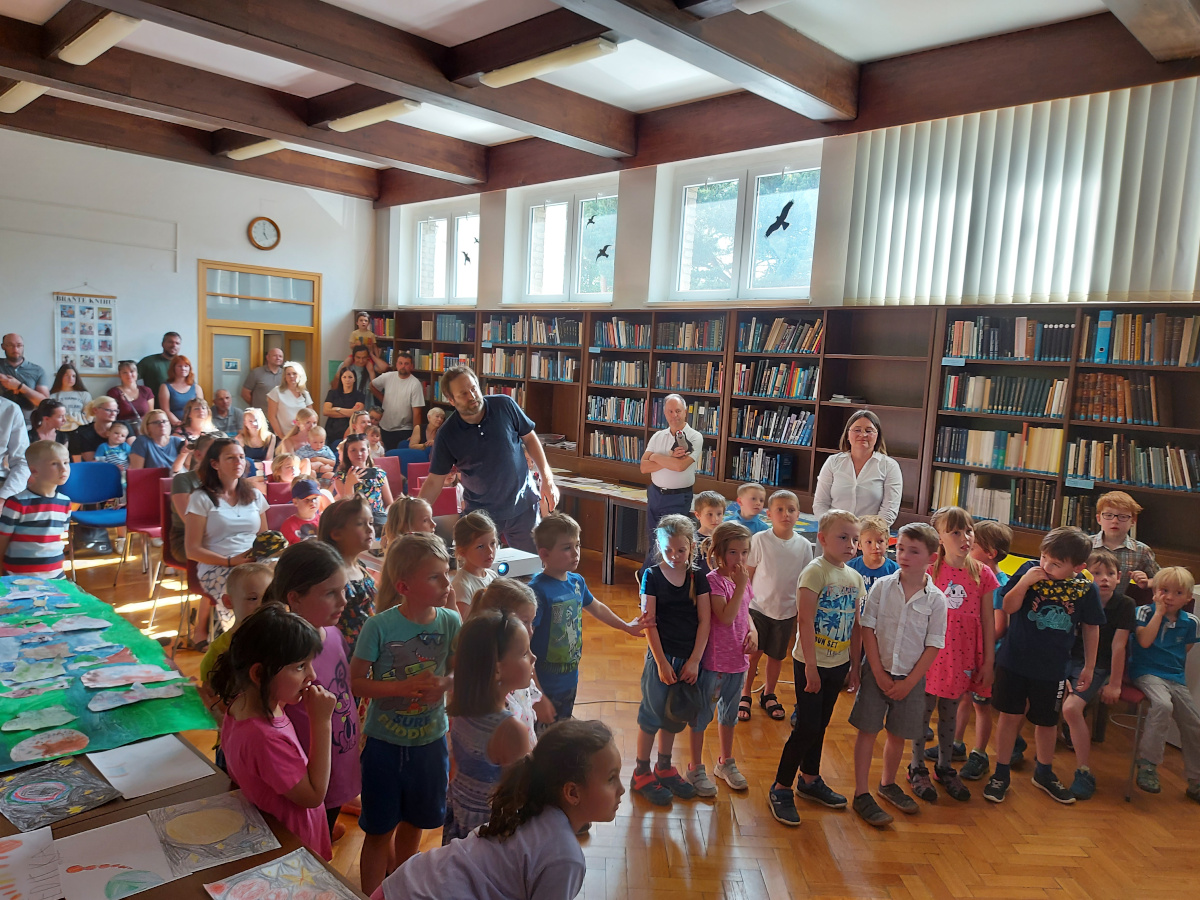
Space through children`s eyes
As every year, the observatory had a pleasure to host a visit from preschoolers from local kindergarten in Ondrejov. Kids visited the control room of the Perek telescope, later they saw the telescope in the dome and they also saw a presentation about the life of stars projected on the roof of the telescope dome. The whole visit was finished with experiments with liquid nitrogen which was very enjoyable for the kids but also for us when freezing leaves and other small stuff.
One month later in May, the project concluded by a small presentation of kids work themed life of stars to parents and families of the kids. Beautiful paintings were presented by kids and teachers and the whole event was introduced by the director of the kindergarten Mrs. Romana Brilova, director of AsÚ Mr. Michal Bursa and the mayor of Ondrejov Mr. Vladimír Zámyslický.
Our sincerest thanks go to teachers and the director of the kindergarten who ignite creativity in preschoolers. Very nice trace from the event was left in Chile, where one of the large paintings is now on the wall of E152, Czech telescope and the other is in the Ondrejov town hall.
23.8.2022
Přednáška a prohlídka Perkova dalkohledu v rámci týdne vědy na Jaderce
Dne 22.6. jsme přivítali v Ondřejově mladé naděje fyziky. Skupina celkem 13. středoškoláku se účastnila Týdne vědy na Jaderce a v rámci jejich programu jsme uspořádali přednášku o výzkumu exoplanet a o moderních observatořích. Po přednášce jsme se vydali se studeny na prohlídku Perkova dalekohledu a spektrografu a poté i areálu hvězdárny s historickými dalekohledy. Akce se vydařila a věříme, že si studenti odnesli nové poznatky a třeba i nějakou motivaci pro další studium přírodních věd.
22.8.2022
Návštěva ze ZŠ Dubeč/Visit of pupils from elementary school Dubeč
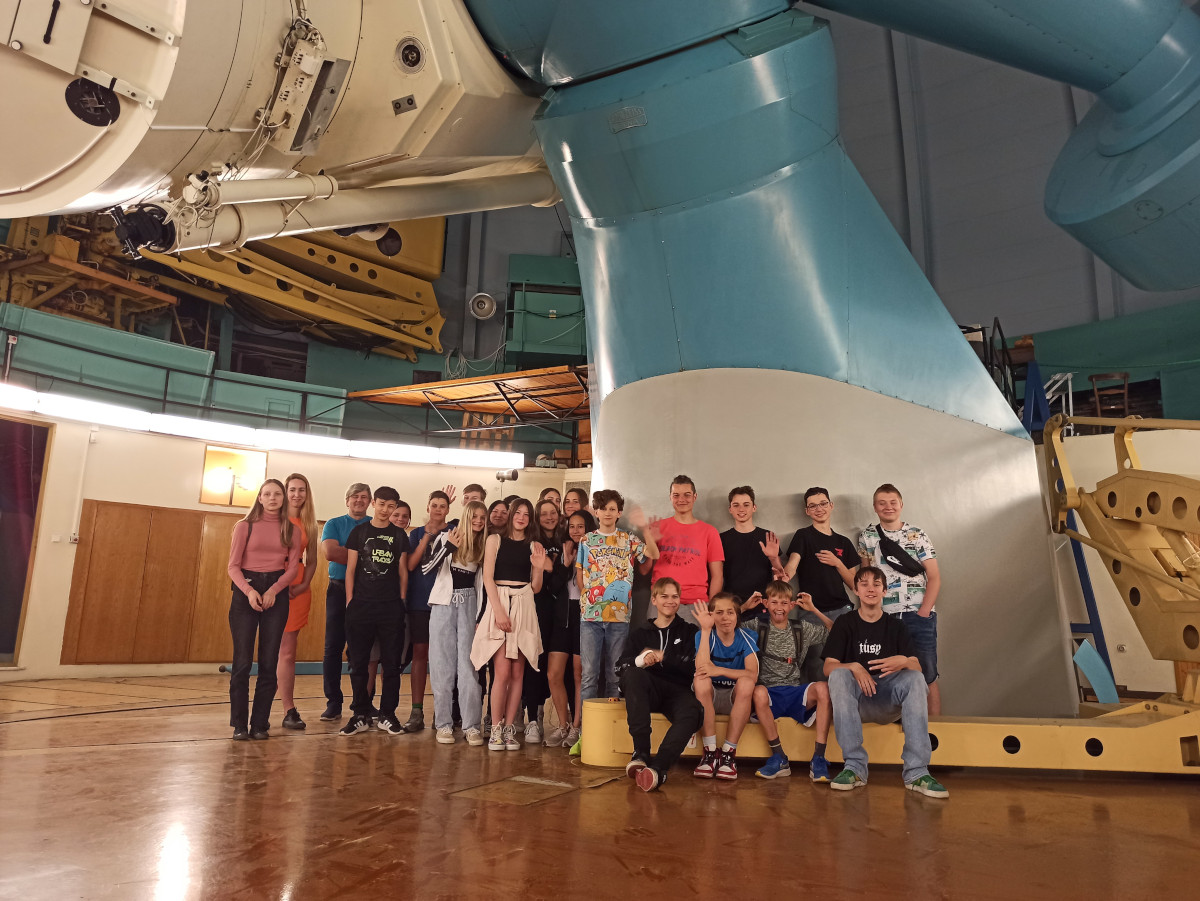
Jedno květnové odpoledne (12.5.) jsme hostili nadané žáky ze ZŠ Dubeč, kteří se díky řediteli ZŠ, který vede rozšířenou výuku fyziky, zajímají o vesmír a měli skvělé znalosti. Nejdříve jsme si povídali o vzniku a vývoji vesmíru, plynule jsme přešli k hvězdám a exoplanetam a nakonec k tomu, jak hvězdy končí svoji životní pouť. Následná diskuse se rozpoutala o kvantových jevech na horizontu události černé díry a vzniku vesmíru. Po diskusi jsme se vypravili k Perkovu dalekohledu. Doufáme, že návštěva byla přínosná pro žáky. My jsme byli mile překvapeni hloubkou diskuse, která se rozpoutala a věříme, že i kdyby jen jeden z žáku se díky návštěvě třeba někdy v budoucnu věnoval přírodním vědám účel návštěvy bude splněn.
One afternoon in May, pupils from elementary school Dubeč visited the observatory. We presented various topics ranging from the beginnings of the universe to life and death of stars and exoplanets. After the presentation, an extremely interesting discussion about event horizon of black holes began. We almost could not leave to see the telescope and instrumentation. It is amazing to see the enthusiasm and the knowledge of kids who keen to learn about space.
23.8.2022
Jorge Garcia Rojas - “The candy islands skies” - talk in person for children of 5th grade and online for children of 4th and 6th grade.
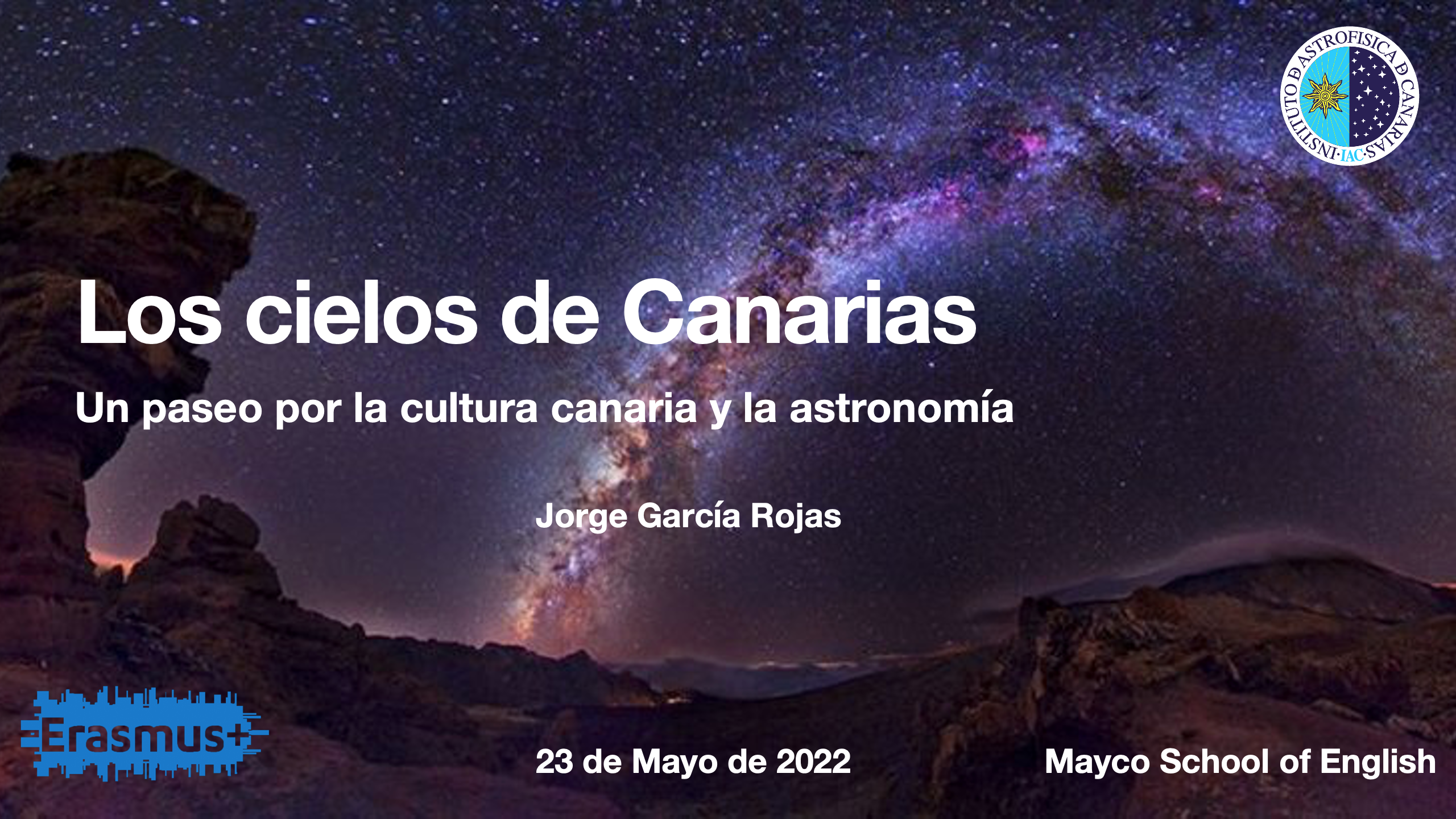
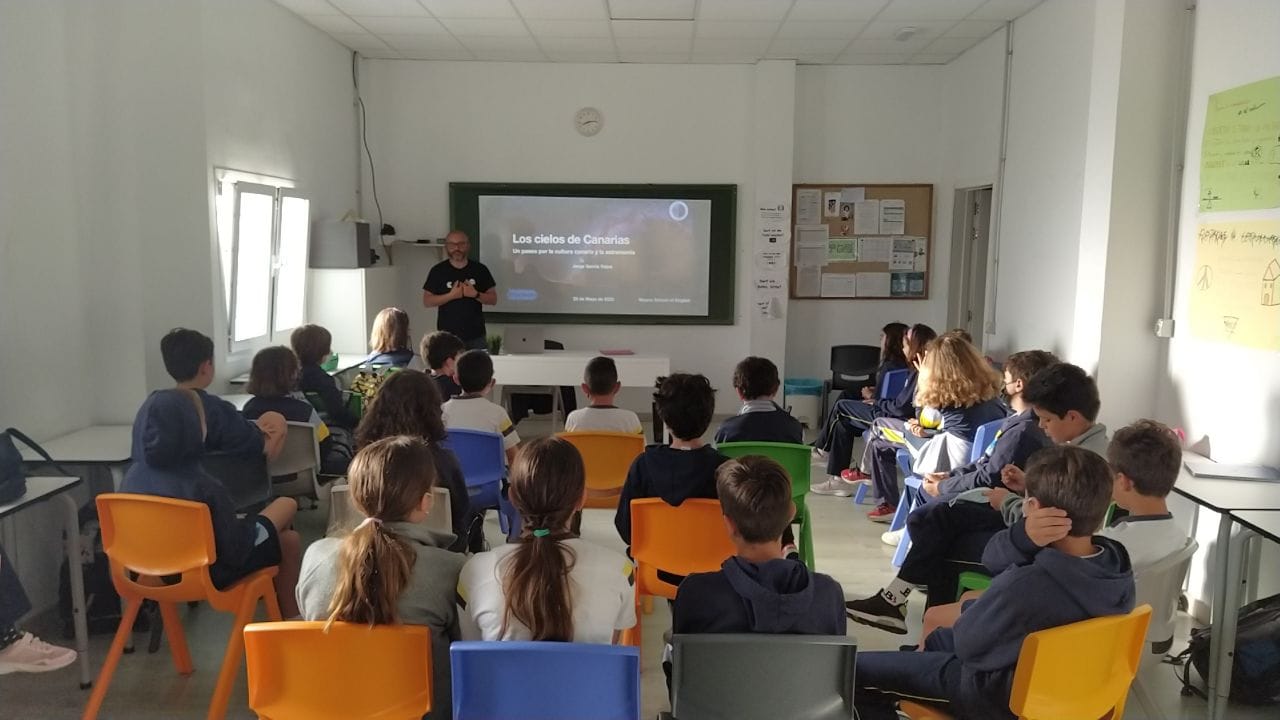
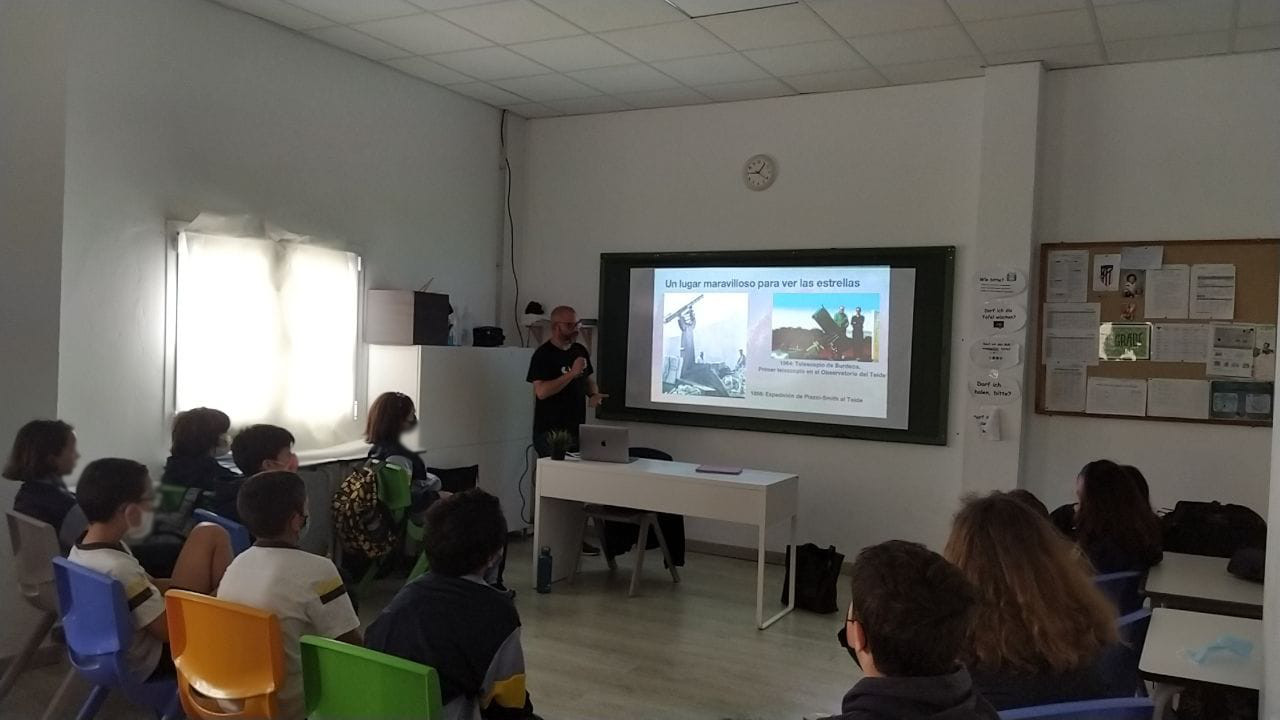
7.7.2022
Visitas de estudiantes de secundaria al Observatorio del Roque de Los Muchachos
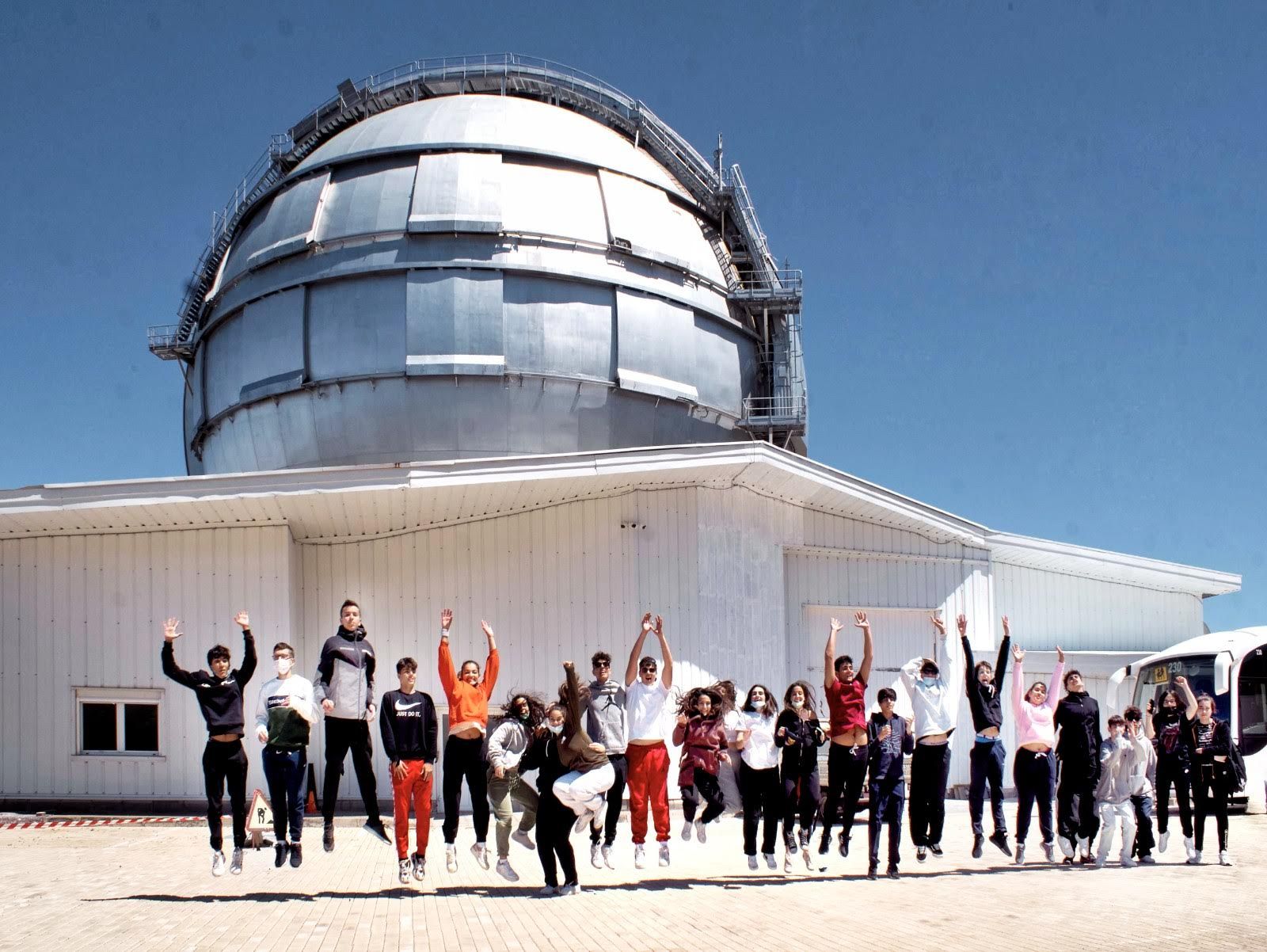 El alumnado de 4º de la ESO del Colegio Santo Domingo de Guzmán de Santa Cruz de La Palma, conocido por La Palmita, ha vuelto al
Observatorio del Roque de Los Muchachos (ORM) en la actual etapa de normalización de la pandemia para visitar el Centro de Visitantes
y el Gran Telescopio Canarias (GTC). “Dos astrofísicos del GTC y del Instituto de Astrofísica de Canarias (IAC), y el personal del
Centro de Visitantes nos atendieron y explicaron qué ciencia se hace en El Roque y la importancia de que el ORM esté La Palma”,
explica un profesor del centro, quien destaca que “la clásica imagen del salto ante el Gran Telescopio Canarias hacía tres años
que no podíamos realizarla por la pandemia”.
El alumnado de 4º de la ESO del Colegio Santo Domingo de Guzmán de Santa Cruz de La Palma, conocido por La Palmita, ha vuelto al
Observatorio del Roque de Los Muchachos (ORM) en la actual etapa de normalización de la pandemia para visitar el Centro de Visitantes
y el Gran Telescopio Canarias (GTC). “Dos astrofísicos del GTC y del Instituto de Astrofísica de Canarias (IAC), y el personal del
Centro de Visitantes nos atendieron y explicaron qué ciencia se hace en El Roque y la importancia de que el ORM esté La Palma”,
explica un profesor del centro, quien destaca que “la clásica imagen del salto ante el Gran Telescopio Canarias hacía tres años
que no podíamos realizarla por la pandemia”.
Este docente expresa su gratitud “a todas las personas e instituciones que hacen posible este programa” y asegura que “volveremos”.
Source HERE
30.5.2022
School visits to the Roque de Los Muchachos Observatory
In May 2022, Dr. Jones oversaw visits to the Roque de los Muchachos Obseravtory from more than 100 high school students from La Palma (IES El Paso, IES Villa de Mazo and La Palmita). As part of each visit, the students were given a guided tour of the recently inaugurated visitors centre, featuring interactive modules explaining the importance of the observatory and the pioneering science undertaken there. After which, the students were given the unique opportunity to go inside the Gran Telescopio CANARIAS - the world's largest optical-infrared observatory - learning how the telescope operates and the scientific discoveries it has made.
Visitas de estudiantes de secundaria al Observatorio del Roque de Los Muchachos
En Mayo 2022, Dr. Jones organizó visitas al observatorio de más de 100 estudiantes de 4o de ESO de La Palma (IES El Paso, IES Villa de Mazo y La Palmita). Las visitas empezaban con un tour guiado del recién inaugurado centro de visitantes, incluyendo la oportunidad de interaccionar con los módulos del centro explicando la importancia del observatorio y la ciencia que se hace allí. Después, tuvieron la oportunidad de visitar el Gran Telescopio CANARIAS - el mayor telescopio óptico-infrarrojo del mundo - donde aprendieron sobre las operaciones del telescopio y los descubrimientos que se ha hecho con ello.
24.5.2022
Astrophysics: a journey through the light
Dr. Jorge Garcia Rojas - talk at a secondary school (I.E.S. San Matías) in Tenerife.
In this talk given to students of 3rd grade of secondary school (14-15 years) and 2nd grade of Baccalaureate (17-18 years) I tried to summarize to students how astrophysics take advantage of the different wavelengths ranges of the electromagnetic spectrum to study the physical properties of celestial objects. I also briefly explained them the importance of technical advances in space telescopes and instrumentation to answer some of the main questions that modern astrophysics has raised in the last years.I also developed with the students a small workshop on how an infrared camera works and the differences between visible and infrared light.
Título: Astrofísica: un viaje a través de la luz
En esta charla impartida a alumnos de 3º de ESO (14-15 años) y 2º de Bachillerato (17-18 años) traté de resumir a los alumnos cómo la astrofísica aprovecha los diferentes rangos de longitudes de onda del espectro electromagnético para estudiar las propiedades físicas de los objetos celestes. También les expliqué brevemente la importancia de los avances técnicos en los telescopios espaciales y la instrumentación para responder a algunas de las principales preguntas que la astrofísica moderna ha planteado en los últimos años. También desarrollé con los alumnos un pequeño taller sobre el funcionamiento de una cámara de infrarrojos y las diferencias entre la luz visible y la infrarroja.
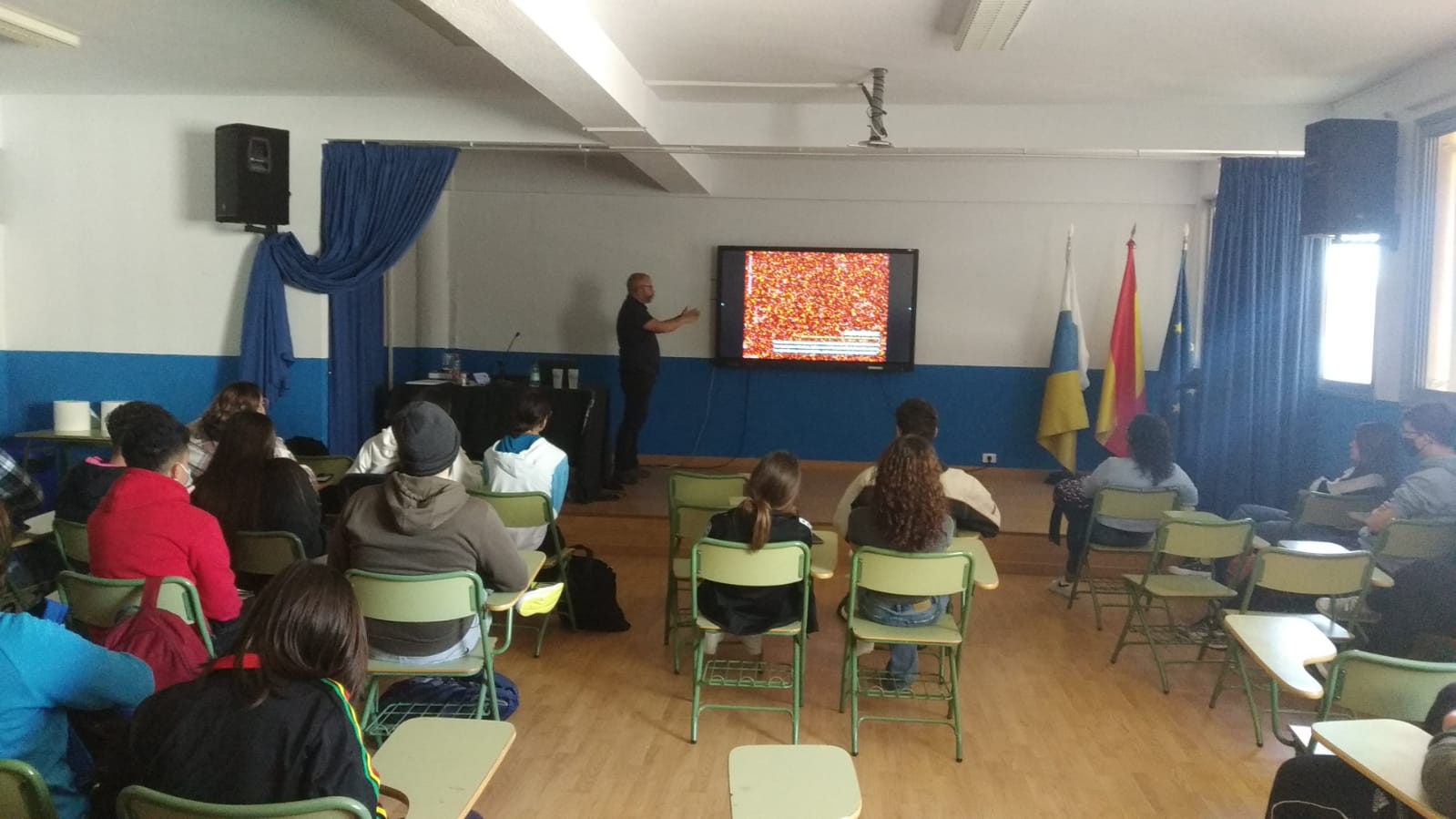
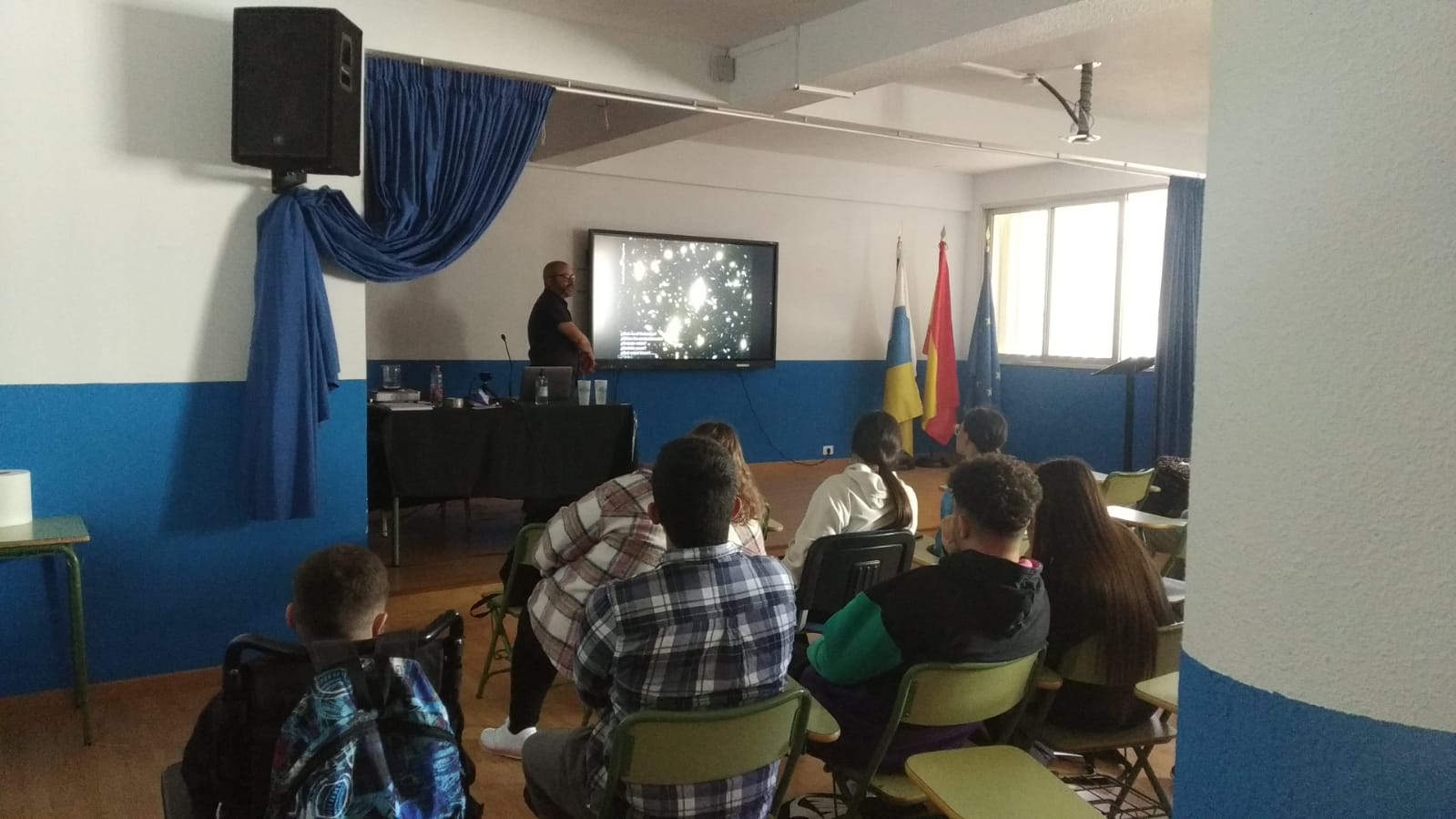
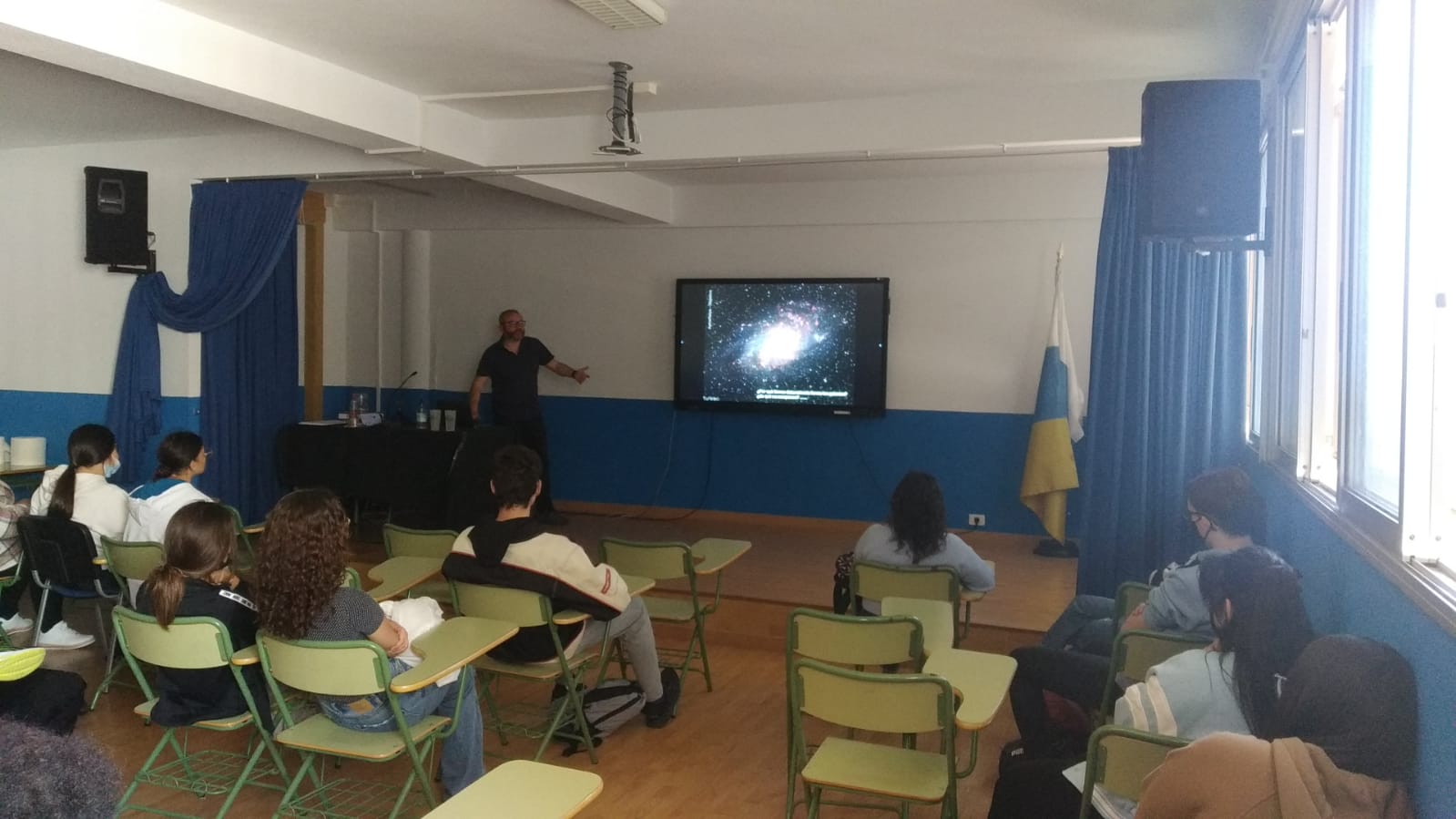
5.5.2022
“Astronomical Instrumentation” talk and a small workshop with an infrared camera at the Secondary School “IES Mesa y López” in Las Palmas de Gran Canaria
Dr. Jorge Garcia Rojas - talk at a secondary school (I.E.S. Mesa y López) in Gran Canaria.
Title: Astronomical instrumentation
In this talk given to 16-17 years old students (1º Bachillerato) we made a journey through astronomical instrumentation across the time: from the nude eye to the most modern ground-based and space telescopes. We focused on optical and infrared capabilities like GTC (the largest optical-near IR telescope in the world) and the JWST, trying to give the students a broad view of the advanced instruments and techniques that make these telescopes the most advanced ones to date. I also gave a sketch of some of some future instruments/facilities in which the IAC has an important role, such as the PLATO mission or the HARMONI spectrograph for the E-ELT. As a complementary activity, we carried out a small workshop with an infrared camera where the students were able to see "in-situ" how there are materials that are opaque to visible light and transparent to IR light, and vice versa.
Título: Instrumentación astronómica
En esta charla impartida a alumnos de 16-17 años (1º Bachillerato) hicimos un recorrido por la instrumentación astronómica a lo largo del tiempo: desde el ojo desnudo hasta los más modernos telescopios terrestres y espaciales. Nos centramos en instalaciones ópticas e infrarrojas como el GTC (el mayor telescopio óptico-IR cercano del mundo) y el JWST, tratando de dar a los alumnos una visión amplia de los instrumentos y técnicas avanzadas que hacen de estos telescopios los instrumentos astronómicos más avanzados hasta la fecha. También hice un esbozo de algunos de los futuros instrumentos/instalaciones en los que el IAC tiene un papel importante, como la misión PLATO o el espectrógrafo HARMONI para el E-ELT. Como actividad complementaria, realizamos un pequeño taller con una cámara infraroja en donde los alumnos pudieron comprobar "in-situ" como hay materiales opacos a la luz visible, que son transparentes a la luz IR, y viceversa.
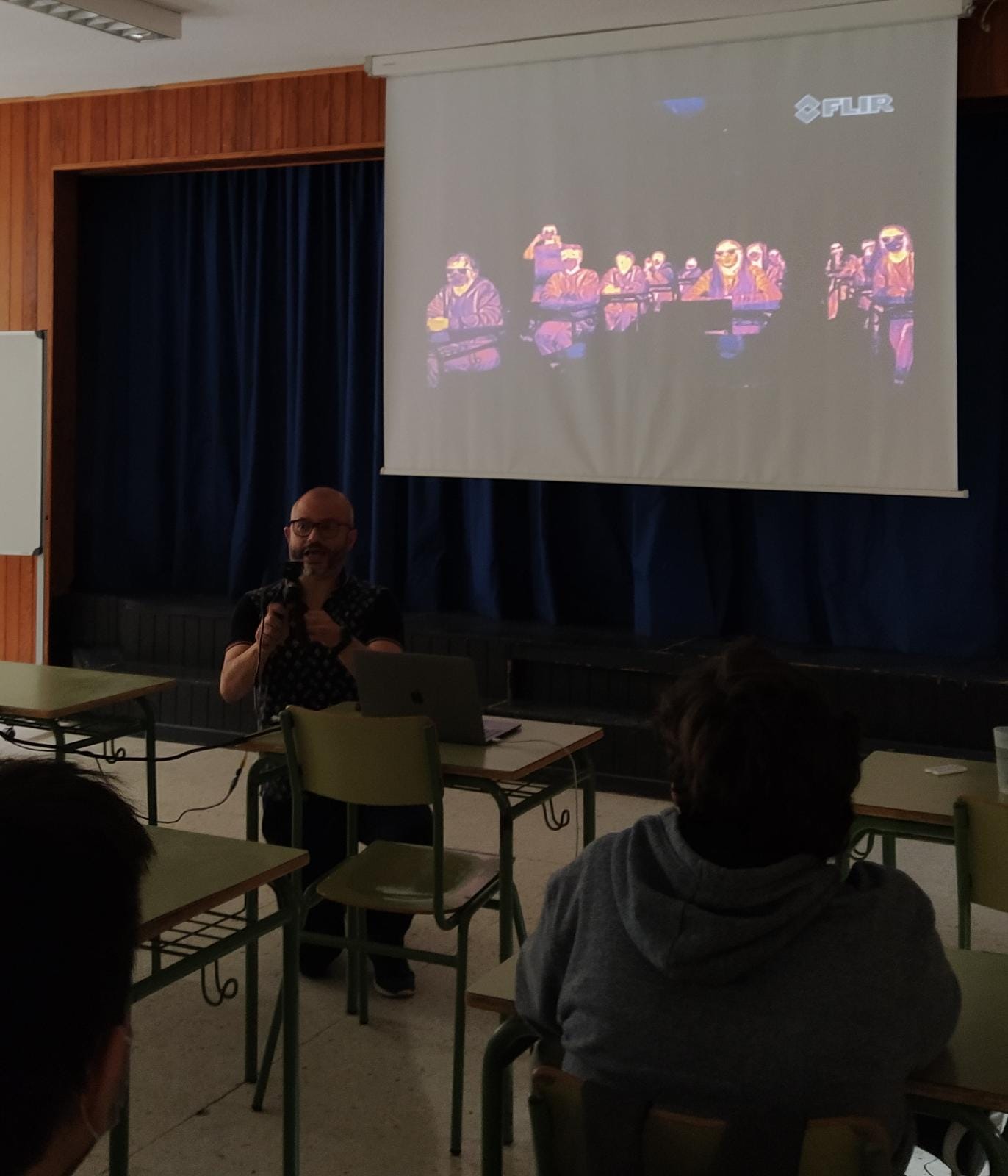
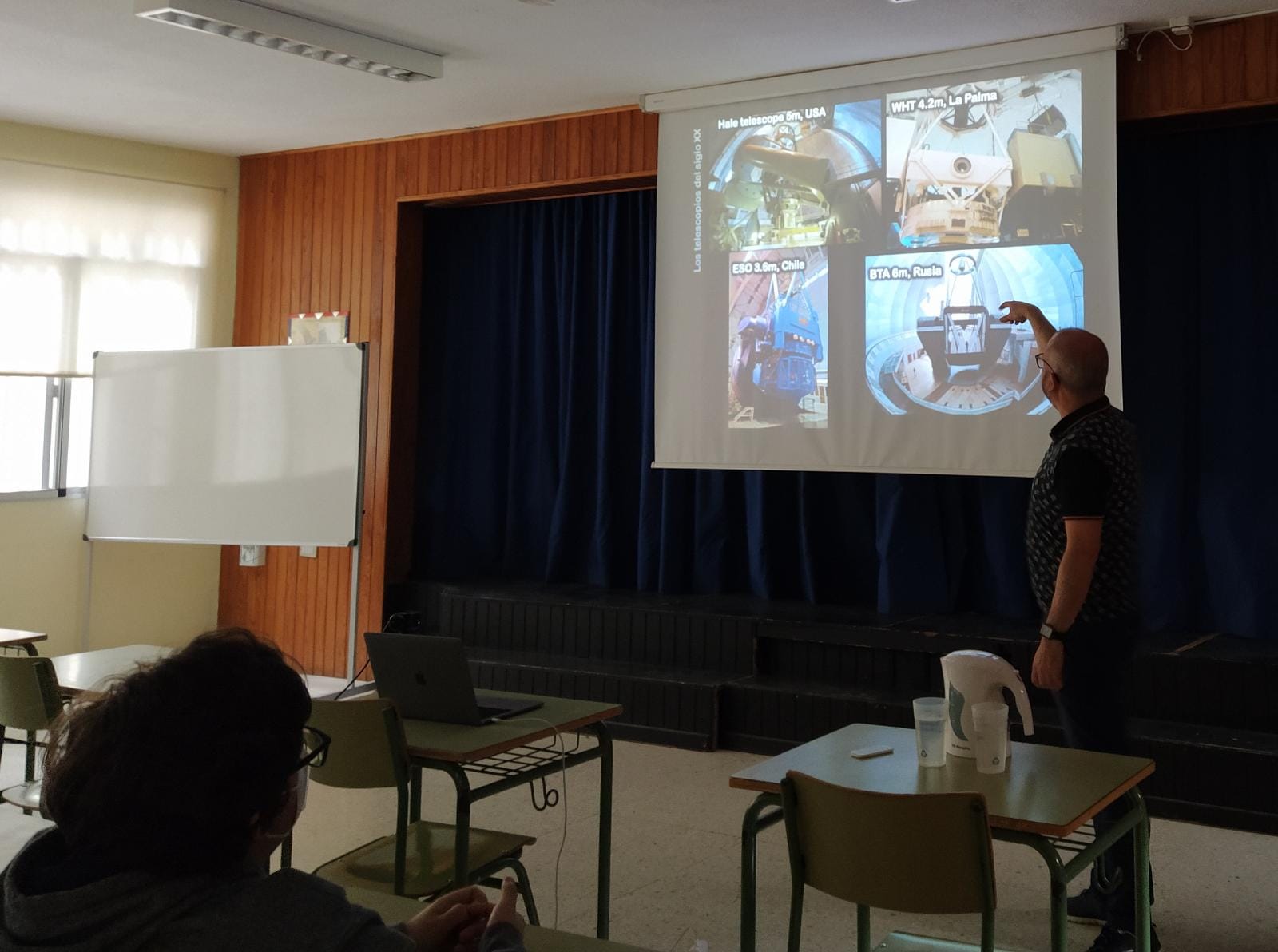
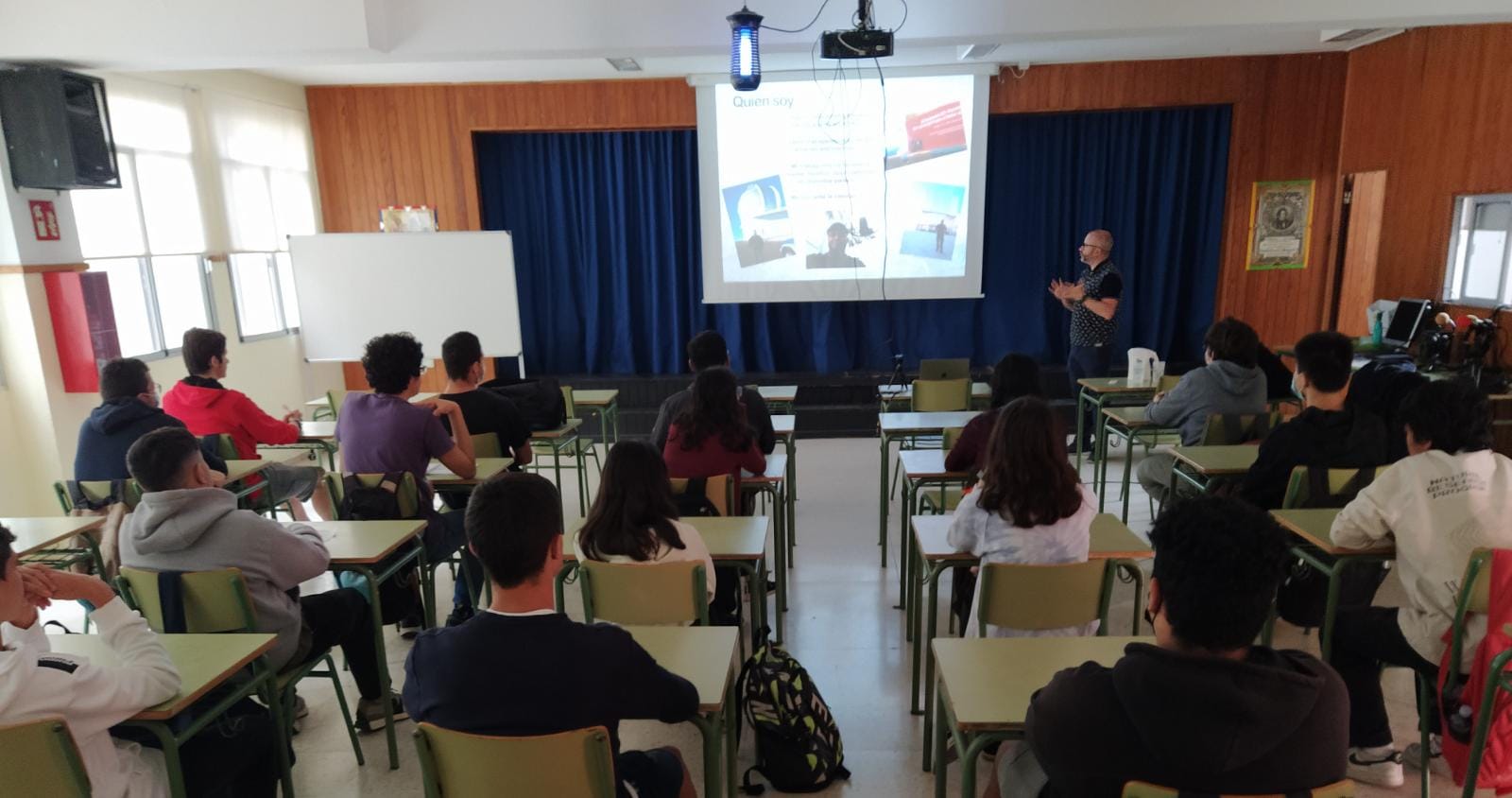
5.5.2022
Astrophysics: a journey through the light
workshop for secondary school students (15-17 years) - Las Palmas de Gran Canaria
Speaker: Jorge Garcia Rojas
15.3.2022



Presentation here
18.3.2022
Astronomy at ancient times on Canary Islands
More here
EN version
ERASMUS+ YouTube kanál
Více zde
CZ EN ES version
Konference Americké geologické unie (AGU)
Více zde
CZ EN version
Astronomický kroužek v Brně
Více zde
CZ EN version
ZARoK (setkání členů sekce Zákrytové a Astrometrické v Rokycanech)
Více zde
CZ EN version
Astronomicka expedice HP Rokycany/Plzen
Více zde
CZ EN version
Echelle spectroscopy course in Ondřejov
In the week of August 30-September 3, 2021, the first year of lectures dedicated to echelle spectroscopy and radial velocity determinations was held at the Astronomical Institute of the Czech Academy of Sciences in Ondřejov. Six MSc. students from the Masaryk University in Brno and Charles University in Prague learned how to reduce echelle spectra and estimate radial velocities in the IRAF package, as well as to determine radial velocities in various software packages (e.g. Exostriker) under the supervision of Dr. Marek Skarka, Dr. Petr Kabáth and their doctoral students Mgr. Magdalena Špoková and Mgr. Ján Šubjak. The emphasis was put on the practical work in the way that each of the students had to go through all the steps of the data reduction and analysis on his/her own. To cover the most possible diversity of the issues that can come up during the analysis, the students reduced data with different quality. In addition, they analysed three objects with different amplitude of the radial velocities that they did not know in advance. For example, one of the objects was an exoplanetary candidate that has the radial velocity amplitude under the detection limit of the used instrument. For the tutorial, we used archival spectra obtained with the Ondřejov echelle spectrograph mounted on the 2m Perek telescope. Except for the work, there was also space for other common activities such as the welcome party. The project was supported by the ERASMUS+ project.
Public Events
Vysokoenergetické žiarenie
Mgr. Patrik Čechvala, Fakulta matematiky, fyziky a informatiky Univerzita Komenského v Bratislave
link na článek zde
Najnovší diel 3x3 o vesmíre s názvom „3 zaujímavosti nočnej oblohy“
3 zaujímavosti nočnej oblohy | 3x3 o vesmíre. Hosť: Patrik Čechvala , moderuje: Karol Havrila
3x3 o vesmíre
seriál YouTube videí, rozhovory, novinky a zaujímavosti z blízkeho aj ďalekého vesmíru
Čiastočné zatmenie Slnka | Matfyz livestream
Dňa 10.6. sa môžeme tešiť na zatmenie Slnka, ktoré z nášho územia uvidíme iba ako čiastočné. V maxime bude zakrytých približne 4% slnečného disku. Začiatok zatmenia nastane o 11:55 SELC a koniec zatmenia bude o 13:28 SELČ
Počas livestreamu budeme pozorovať toto čiastočné zatmenie, rozprávať sa s hosťami o vesmíre a astronómii, a skladať LEGO Ideas 21321 - Medzinárodná vesmírna stanica ISS
Odborná prednáška v rámci workshopu „Kozmologické a antropologické aspekty budúcnosti ľudstva: Na Mars a späť“, ktorý sa uskutočnil na AGO
Modra 9.7.-10.7. 2021
Názov: Ľudstvo ako interplanetárny druh
Autor: Roman Nagy, Tomáš Paulech
El cielo de Canarias (activity for school kids)
[EN]
The activities developed in “Las Mercedes primary school” in La Laguna, Tenerife were planned for kids of 4th grade (9-10 years) in theframework of an educational project called “The sky of the Canary Islands”. Jorge García-Rojas gave a talk about the observation of the sky in Canary Islands through the history, from the ancient aborigines to the largest optical-IR telescope in the world. Two short and funny workshops were carried out about the solar system and the Universe-Earth history in a year timescale. The experience was very grateful for the astronomer and the kids, who were heavily involved in all the activities and bombarded the astronomer with tons of questions and comments, most of them very interesting.
[ES]
Las actividades desarrolladas en el colegio de primaria “CEIP Las Mercedes" de La Laguna, Tenerife, fueron planificadas para niños de 4º de primaria (9-10 años) en el marco de un proyecto educativo denominado "El cielo de Canarias". Jorge García-Rojas impartió una charla sobre la observación del cielo en Canarias a través de la historia, desde los antiguos aborígenes hasta el mayor telescopio óptico-infrarrojo del mundo. Se realizaron dos breves y divertidos talleres sobre el sistema solar y la historia del Universo-Tierra en una escala de tiempo de un año. La experiencia fue muy enriquecedora tanto para el astrónomo como para los niños, que se implicaron mucho en todas las actividades y bombardearon al astrónomo con toneladas de preguntas y comentarios, la mayoría de ellos muy interesantes.
Link to the presentation .pdf
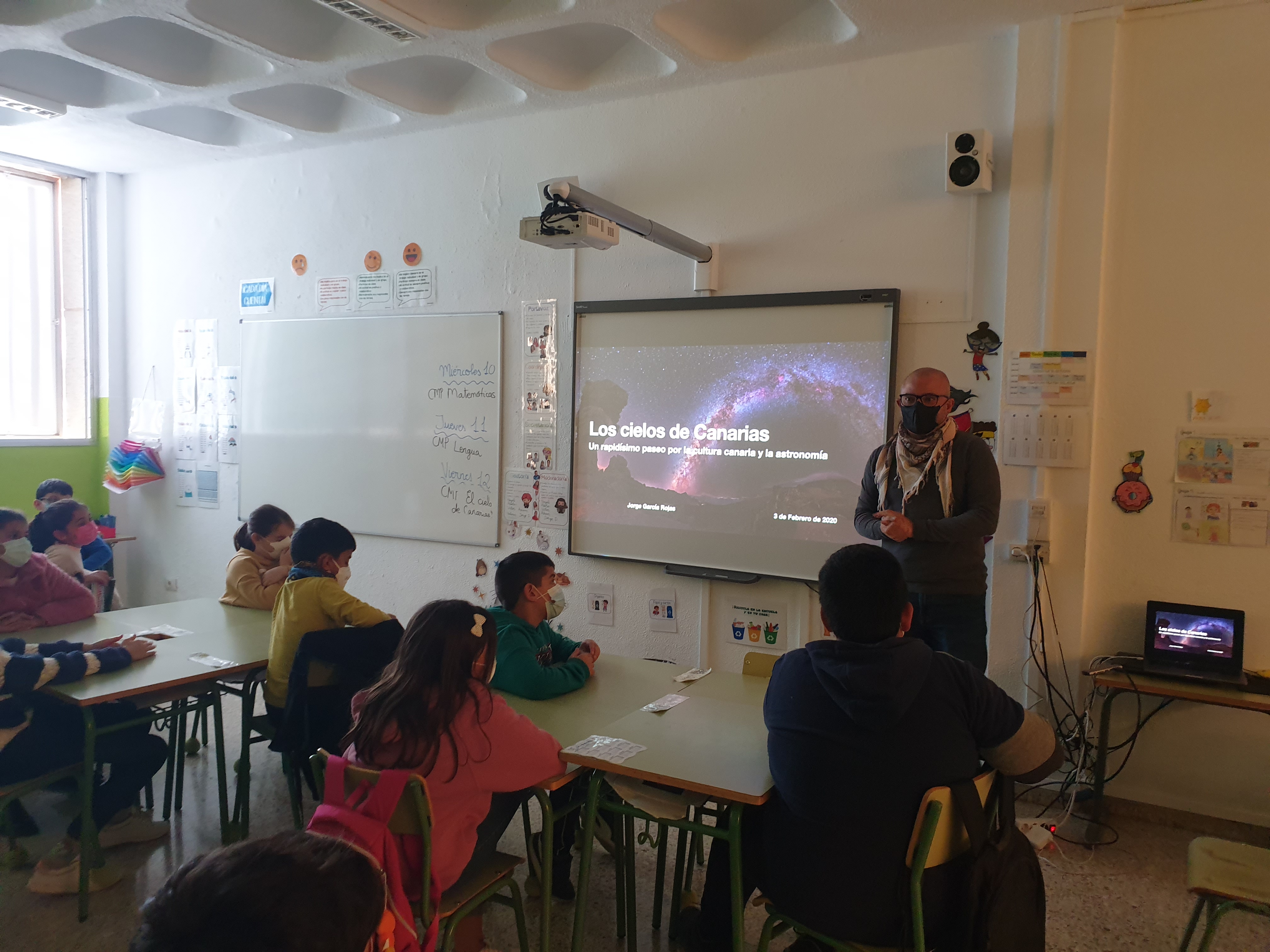
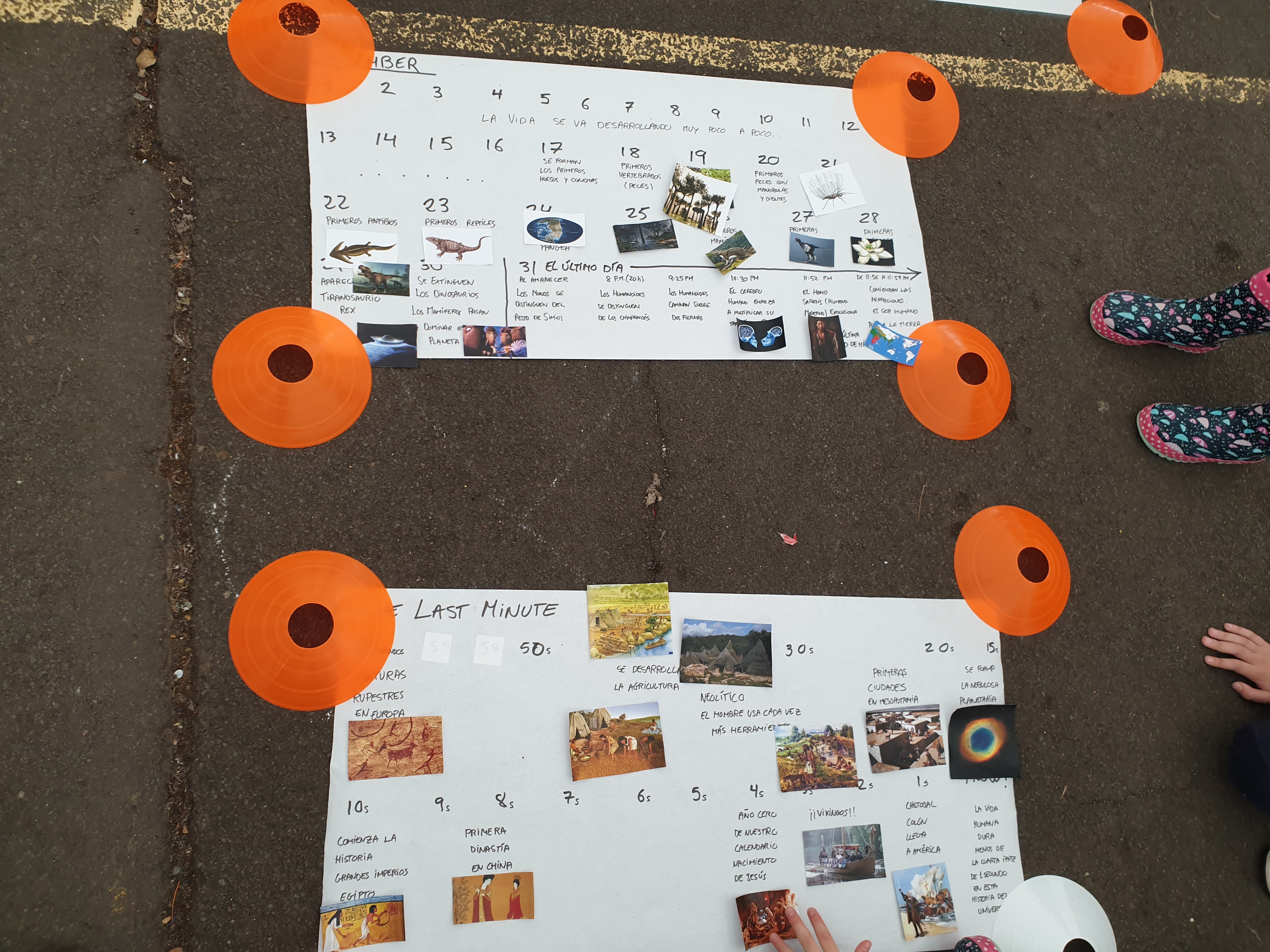
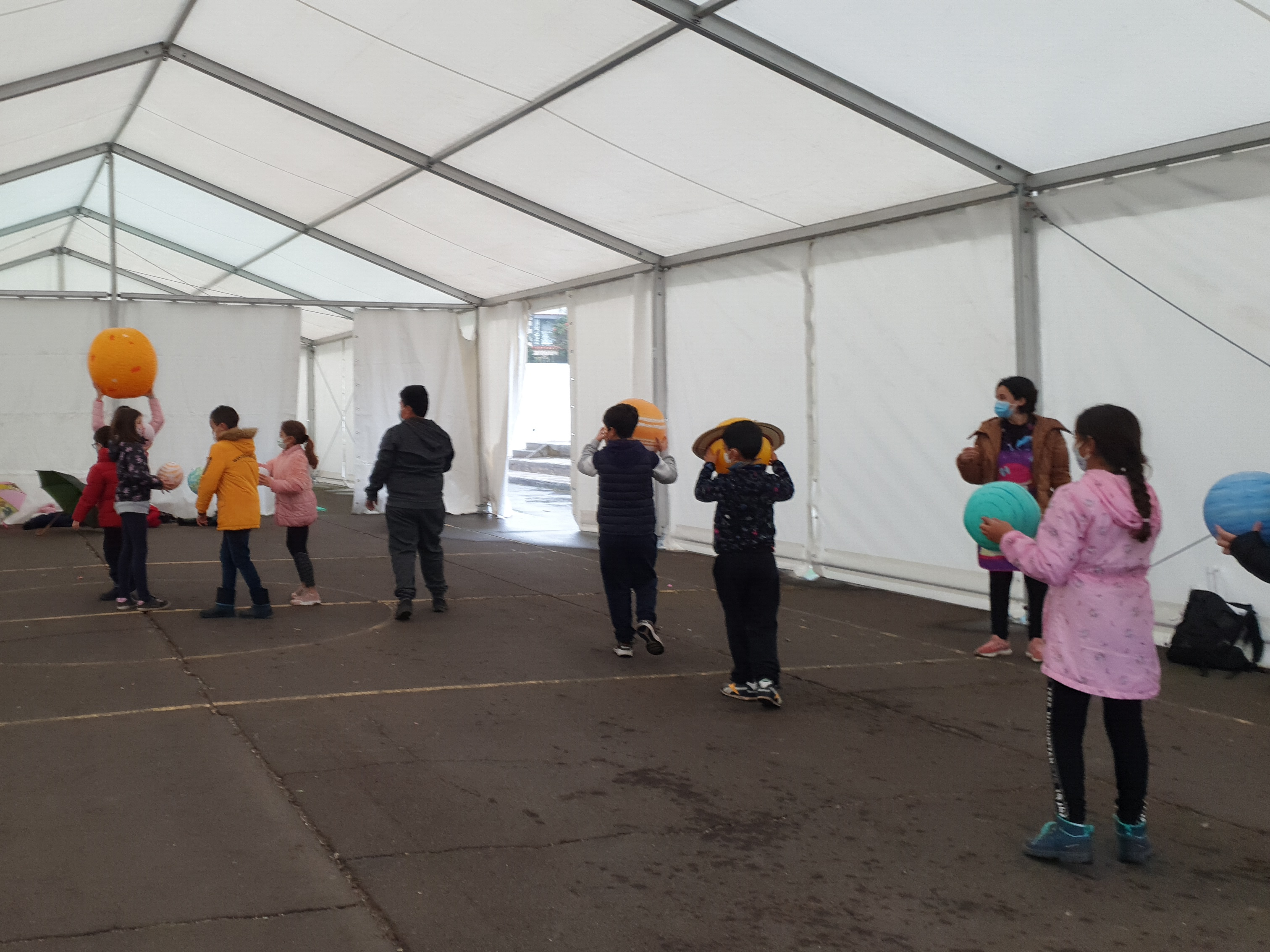
At the 2021 Trendy 3 Virtual Workshop, David Jones presents their talk “Triple Evolution Through the Planetary Nebula Phase."
Common envelope evolution: From binary star chrysalis to cosmic butterfly - David Jones
Planetary nebulae are some of the most strikingly beautiful astrophysical phenomena known, gracing many a glossy-paged, coffee-table book and earning them the nickname "cosmic butterflies". While classical stellar evolutionary theory states that planetary nebulae are the end products of intermediate mass stars, forming as the star leaves the Asymptotic Giant Branch and evolves towards the white dwarf phase, it is now clear that a significant fraction of planetary nebulae originate from a binary evolutionary pathway. As the immediate products of the common envelope, close-binary central stars of planetary nebulae offer a unique tool with which to study this rather poorly understood phase of binary evolution. Furthermore, as the nebula itself represents the ionised remnant of the ejected common-envelope, such planetary nebulae can be used to directly probe the mass, morphology and dynamics of the ejecta. Here, I will summarise our current understanding of the importance of binarity in the formation of planetary nebulae as well as what they can tell us about the common envelope phase - including the possible relationships with other post-common-envelope phenomena like novae and type Ia supernovae.
Exoplanety z vesmíru - Marek Skarka
Pozorování a výzkum exoplanet patří k nejdůležitějším a zároveň nejobtížnějším disciplínám soudobé astronomie. Přesná data je sice možné získat i z povrchu Země, ale nesrovnatelně lepších výsledků lze dosáhnout z vesmírného prostoru, kde neruší zemská atmosféra. Vesmírné mise jako HST, CoRoT, Kepler či TESS způsobily revoluci v našem chápání planet mimo Sluneční soustavu. A chystají se další. Přednáška se bude věnovat zejména technickým parametrům jednotlivých misí a zásadním objevům, které byly s jejich pomocí učiněny.
Observatoř na ostrově La Palma - Marie Karjalainen
V rámci přednášky se dozvíte, jaké jsou na observatoři na La Palmě (Kanárské ostrovy) dalekohledy, jaké je jejich přístrojové vybavení a využití pro zkoumání vesmírných objektů. Povíme si o nejvýznamnějších dosažených vědeckých výsledcích uskutečněných na základě pozorování na tamních dalekohledech. Speciální pozornost budou mít extrasolární planety a vysoce energetické objekty. Přednášející také přiblíží každodenní život a práci astronomky na tomto malém ostrově.
Noc vědců 2020 - záznam živého vysílání na téma exoplanet
Záznam diskuze s vědeckými pracovníky ASU o exoplanetách